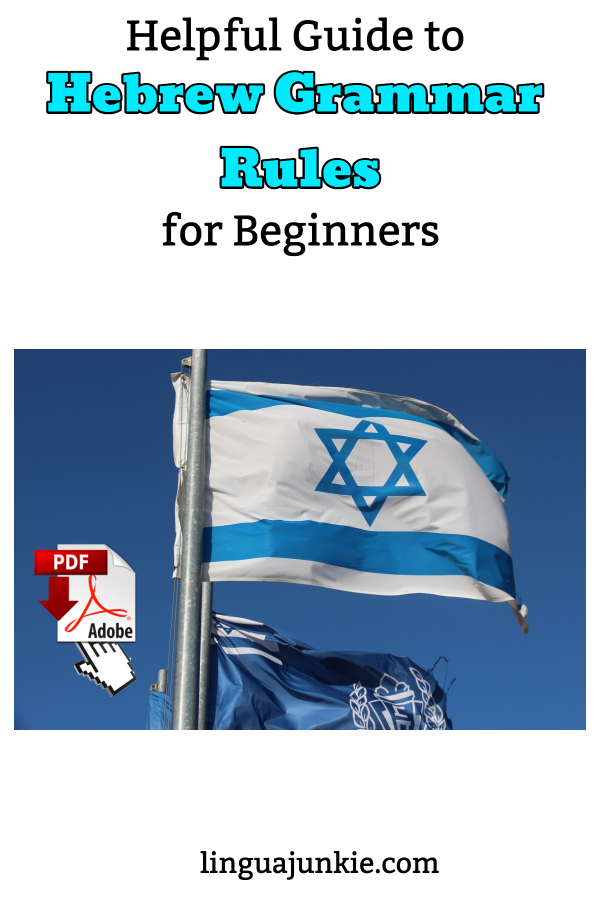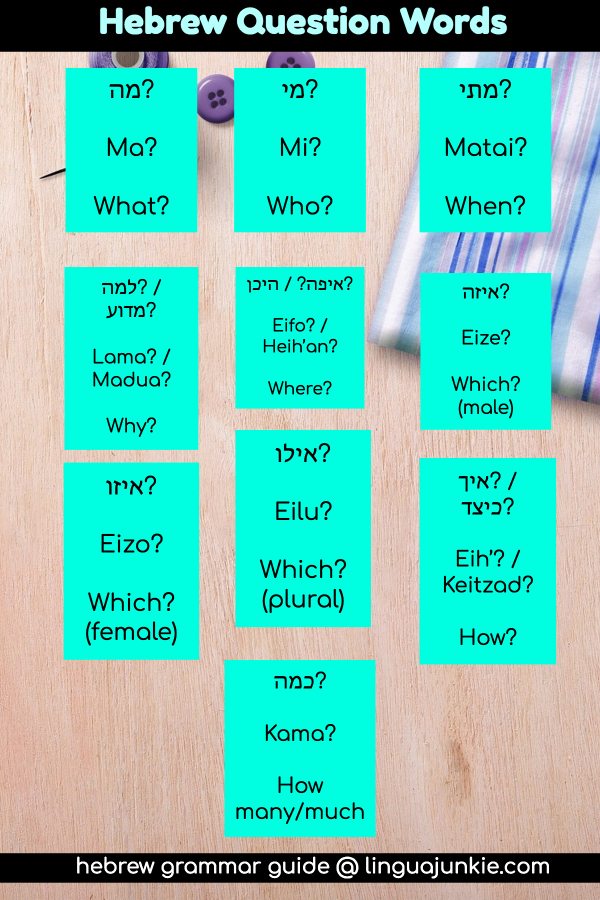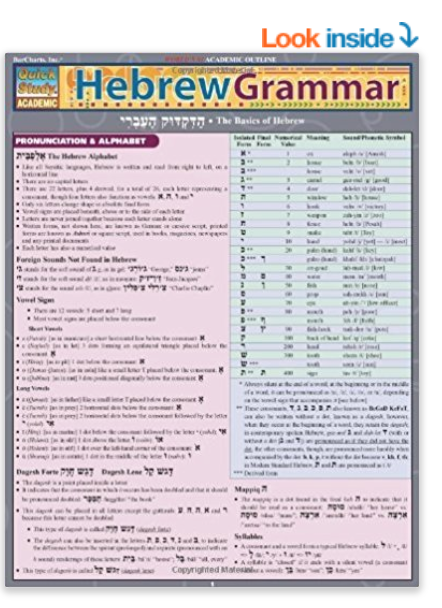Hebrew Grammar is pretty easy.
Hi there,
Either you started learning or want to learn Hebrew. And, you want to brush up Hebrew Grammar basics. So, this friendly Hebrew Grammar Rules is a quick little introduction for you.
Note: If you’re looking for Biblical Hebrew grammar, see this article. This introduction-level lesson focuses on Modern Hebrew grammar rules.

1. Hebrew Right to Left Reading Direction
The first thing that you notice when starting to learn Hebrew is its reading and writing direction. Unlike English and most other languages of the world, Hebrew is read and written in the direction from right to left.
Yes, you just have to get used to it at first.
But, after taking your first few Hebrew lessons, everything will become more natural for you.
There is nothing to it except practice, practice, practice.
2. Pronouns
There are 10 personal pronouns in Hebrew, while there are 8 in English:
One thing that might be confusing is that there are two different variations for the Hebrew pronouns “You”(plural and singular) and “They”.
Singular | Phonetics | English | Plural | Phonetics | English |
אני | “ani” | I | אנחנו | “anah’nu” | We |
אתה | “ata” | You (masculine) | אתם | “atem” | You (m) |
את | “at | You (feminine) | אתן | “aten” | You (f) |
הוא | “hu” | He | הם | “hem” | They (m) |
היא | “hi” | She | הן | “hen” | They (f) |
3. Gender in Hebrew
Unlike English, each Hebrew word is either Masculine or Feminine.
How do you know which is which?
There are some simple rules to help you easily distinguish them.
- Most feminine words end with “ה” (“h”) or “ת”(“t”):
- משפחה (“mishpah’a”) – family
- מכונית (“meh’onit”) – car
- רשימה (“reshima”) – list
- אמת (“emet”) – truth
There are also a number of irregular words that do not fall under any rule.
So, you have to memorize them.
Here are some of the most commonly used masculine word.
- They end with letters other than “ה” or “ת”:
- ארץ (“eretz”) – country
- אמא (“ima”) – mother
- דרך (“dereh’ ”) – road
4. The Hebrew verbs
Hebrew verbs are usually based on a three letter root (in Hebrew שורש – “shoresh”).
The rest of the verb is then built on it. These roots can be also the root of some nouns and adjectives.
Here is an example:
- Root: ש-פ-ט (“sh – f/p – t”); י-ד-ע (“y-d-a”)
Here are some words that can be built using the mentioned above roots:
- לשפוט – to judge (“lishpot”) V.
- לדעת – to know something (“ladaat”) V.
- שופט – judge (“shofet”) N.
- ידע – knowledge (“ye-da”) N.
The Hebrew verb has only three main tenses:
- The Past (עבר – “avar”)
- The Present (הווה – “hove”)
- The Future (עתיד – “atid”)
Let’s take a look at an example of a verb (masculine, singular) inflected in all the three tenses:
Root: ש-ח-ק (“s-h’-k”)
Hebrew Past Tense | Hebrew Present Tense | Hebrew Future Tense |
הוא שיחק (“hu sih’ek”) | הוא משחק (“hu mesah’ek”) | הוא ישחק (“hu yesah’ek”) |
He played | He is playing | He will play |
The verb can be inflected depending on who does the action. For example:
- אני משחק (“ani mesah’ek”) – I am playing
- אתה משחק (“ata mesah’ek”) – You (m) are playing
- את משחקת (“at mesah’eket”) – You (f) are playing
- הוא משחק (“hun mesah’ek”) – He is playing
- היא משחקת (“hi mesah’eket”) – She is playing
- אנחנו משחקים (“anah’nu mesah’kim”) – We are playing
- אתם משחקים (“atem mesah’kim”) – You (plural, m) are playing
- אתן משחקות (“aten mesah’kot”) – You (plural, f) are playing
- הם משחקים (“hem mesah’kim”) – They (plural, m) are playing
- הן משחקות (“hen mesah’kot”) – They (plural, f) are playing
5. The Hebrew Adjective
The Hebrew adjective is conjugated based on the gender and number of the item/s it describes.
Let’s have a look at these examples:
- משפחה גדולה (mishpah’a gdola) – a big family
- שולחן גדול (“shulh’an gadokl”) – a big table
- ילדה טובה (“yalda tova”) – a good girl
- ילד טוב (“yeled tov”) – a good boy
6. Sentence Structure
Hebrew sentences are usually constructed like in English: Subject – Verb – Object.
Hebrew verbs are conjugated by gender, number and person.
- אני מדברת אנגלית (“ani medaberet anglit”) – I (female) speak English.
- אנחנו מבקרים חברים (“anah’nu mevakrim h’averim”) – We are visiting friends.
- 7. Conjunctions
When learning a new language, it is always good to know some of the most commonly used conjugations. That way, it ill be easier for you to build up your own sentences and combine simple sentences into larger texts and even paragraphs.
* Note: unlike English, some of the Hebrew conjugations are not written separately from the word that stands right after them. See the description below to discover which ones of them are written independently and which are not:
And
- Hebrew: ו…
- Pronounced: ve… / u…
Example:
- אסף ותומר עושים שיעורים
- Asaf vetomer osim shiurim
- Asaf and Tomer are doing homework
Or
- Hebrew: או
- Pronounced: o
Example:
- מה אני צריך לקנות – לחם או חלב?
- Ma ani tzarih’ liknot – leh’em o h’alav?
- What do I (male) have to buy – bread or mild?
But / However
- Hebrew: אבל
- Pronounced: aval
Example:
- אני יכולה לעשות את זה אבל אין לי זמן עכשיו
- Ani yeh’ola laasot et ze aval ein li zman ah’shav
- I can do it, but I do not have time at the moment.
8. Hebrew Grammar Imperative Tense
Just like English, the Hebrew language also has the imperative tense.
What’s the imperative tense? It’s when you give a comment or request.
But, unlike English, it is formed in a slightly different way.
For that purpose we use second person singular or plural in most cases.
We add “אל” (“all” – don’t) to negate.
Let’s have a look at the following examples to get a better understanding of how the Hebrew imperative tense is:
Hebrew | Phonetics | English |
שב | shev | Sit down! (to a male) |
אל תזוזי | al tazuzi | Don’t move! (to a female) |
פתח את החלון | ptah’ et hah’alon | Open the window (to a male) |
לכו הביתה, בבקשה | leh’u habayta, bevakasha | Go home, please |
9. Free Hebrew Grammar Lessons & Grammar Courses
Now, I hear you.
It’s one thing to read about Hebrew grammar rules in some article.
It’s another thing to truly learn them. So, of course, you want complete resources, not internet articles.
What do I suggest? Grammar books, courses/apps and hebrew grammar charts.
For books, definitely check out the cheapest ones on Amazon (click here).
With books, you’ll find all of the Hebrew grammar exercises you will need.
What I also recommend are Hebrew grammar charts. Yes, the kind you can stick on your wall. Why? Because grammar is something that you review and come back to day after day. No-one honestly studies grammar for 3 hours a day.
Smart people review it for a few minutes today, then tomorrow, then the day after and so on. So, having a Hebrew grammar chart up on your wall can and will help you master Hebrew grammar rules. You can find plenty of these grammar charts on Amazon. Click here.
Finally you can try Hebrew Grammar Courses.
For that, I recommend an online learning program called HebrewPod101.com.
It’s an audio/video based online Hebrew course that you can take at your pace.
And you can choose from all kinds of audio/video lessons: grammar, culture, conversation, reading, writing and much more. They should have over 500+ lessons across all levels, from Absolute Beginner to Advanced.
So, you’re bound to find some Hebrew grammar excercises inside!
Lessons are usually 3 to 15 minutes long. Not that long, actually. All so you can quickly learn a bit of Hebrew grammar and see or hear it in action. If you’re looking for handy Hebrew grammar charts, you should be able to get a few like this one on Amazon.
Click here to visit HebrewPod101 and get your free lifetime account
10. Question words in Hebrew

When it comes to learning Hebrew grammar, it’s helpful to know the basic question words. In Hebrew, you call them “מילות שאלה” (milot Sheela).
Let’s have a look:
Hebrew | Phonetics | English |
מה? | Ma? | What? |
מי? | Mi? | Who? |
איפה? / היכן? | Eifo? / Heih’an? | Where? |
מתי? | Matai? | When? |
למה? / מדוע? | Lama? / Madua? | Why? |
איזה? | Eize? | Which? (male) |
איזו? | Eizo? | Which? (female) |
אילו? | Eilu? | Which? (plural) |
איך? / כיצד? | Eih’? / Keitzad? | How? |
כמה? | Kama? | How many/much? |
Notes:
- “Where,” or “היכן? (Heih’an?),” is a more official and literary variant of “איפה?” (Eifo?)
- “Why, or “מדוע?” (Madua?) is a more official and literary variant of “למה?” (Lama?)
- And “How” or “כיצד?” (Keitzad?) is a more official and literary variant of “איך?” (Eih’?)
All these official and common variations basically have the same meaning. But, the occasions when you can use them are slightly different. It won’t be a mistake if you use the official question words in everyday speech.
Examples:
1. מי רוצה גלידה?
- Phonetics: Mi rotze glida?
- English: Who want’s some ice-cream?
2. למה החלון פתוח?
- Phonetics: Lama hah’alon patuah’?
- English: Why is the window open?
3. לאיפה אתם הולכים?
- Phonetics: Leeifo atem holh’im?
- English: Where are you (plural) going?
11. The degrees of comparison
After you learn how to describe things in Hebrew, like something is far, beautiful, shiny, big or small, you also want to learn how to compare those things. You want to be able to say that something is “the most” or “the least.”
Here’s how we do it in Hebrew:
- When something is less… than something:
- פחות
- Phonetics: Pah’ot
- Example: הוא פחות נחמד ממנו
- Phonetics: Hu pah’ot neh’mad mimeno
- English: He is less friendly than him.
- When something is more… than something:
- יותר
- Phonetics: Yoter
- Example: הוא יותר גבוה ממנו
- Phonetics: Hu yoter gavoha mimeno
- English: He is higher than him.
- When something is the least…:
- הכי פחות
- Phonetics: Hah’I pah’ot
- Example: זה האוכל הכי פחות אהוב עלי
- Phonetics: Ze haoh’el hah’I pah’ot ahuv alai.
- English: This is my least favorite food.
- When something is the most…
הכי / ביותר
Both words have the same meaning and are completely interchangeable. See the examples below and pay attention to the word order in both examples!
Phonetics: Hah’I / beyoter
Example: הר האוורסט הוא ההר הכי גבוה בעולם (Or הר האוורסט הוא ההר בגבוה ביותר בעולם)
Phonetics: Har haeverest hu hahar hah’I gavoh’a baolam (Or Har haeverst hu hahar hagavoha beyoter baolam)
English: Mount Everest is the highest mountain in the world.
12. The Particle “את”
Patricle “את” is a tricky one because we don’t have an equivalent in the English language.
This Hebrew particle is used to link between the subject and the direct object.
We may somehow compare it to the use of the English indefinite article “a” and indefinite “the”. See the examples below:
Without particle “את” | With particle “את” | |
Hebrew | שרה אכלה תפוח. | שרה אכלה את התפוח. |
Phonetics | Sara ah’la tapuah’. | Sara ah’la et hatapuah’. |
English | Sarah ate an apple. | Sarah ate the apple. |
Explanation | Here the important information is Sarah and that she ate something. | Here the apple is certain apple and the apple is the most important information in the sentence. Unlike the previous case here Sarah ate a specific apple (in some context). |
13. The Letter “ש” (shin)
This is a very interesting letter. In most cases, it is pronounced like “sh”, but in very few cases it is pronounced like “s”. All you have to do is to memorize the particular cases when it sounds like “s”. Here are a few examples:
- שלום – shalom – Hello
- שמש – shemesh – Sun
- שמחה – simh’a – Joy / Happiness
- ששון – sason – Delight
- שדה – sade – Field
14. The Hebrew infinitive
When you know a “shoresh” (the basic form of a Hebrew verb) and want to put it in its infinitive form, all you have to know is the infinitive pattern.
The pattern is:
- לי_ _ו_
- (Li_ _o_)
Shoresh | Infinitive | Phonetics | English |
ז.ר.ק | ליזרוק | Lizrok | To throw |
צ.ח.ק | ליצחוק | Litzh’ok | To lough |
ש.מ.ר | לישמור | Lishmor | To keep |
There are also some exceptions that fall under another pattern:
- ל_ _ו_
- (L_ _o_)
Shoresh | Infinitive | Phonetics | English |
ע.ש.ה | לעשות | Laasot | To do |
ח.ז.ר | לחזור | Lah’zor | To return |
15. The “double” form of the word
This next Hebrew grammar rule is unique to the Hebrew language.
Whenever you want to create a double form of something, use the suffix “-ayim”. It can be used to form numbers, time indicators and to name the parts of our bodies.
Look at the examples below:
Singular form | Phonetics | Meaning | “Double” form | Phonetics | Meaning |
אלף | Elef | One thousand | אלפיים | Alpayim | Two thousands |
יום | Yom | Day | יומיים | Yomayim | Two days |
חודש | H’odesh | Month | חודשיים | H’odshayim | Two month |
יד | Yad | Hand | ידיים | Yadayim | Two hands |
עין | Ayin | Eye | עיניים | Einayim | Two eyes |
שעה | Shaa | Hour | שעתיים | Shaatayim | Two hours |
פעם | Paam | Time (in the meaning of one time) | פעמיים | Paamayim | Two times |
Note:
You can’t use this suffix to form a “double” variant of each and every word; you will just have to memorize these ones.
And that’s it!
Now, you should have a bit of an understand of Hebrew grammar rules. Yes, you cannot learn it all in a day. That’s why you need resources and to practice a little bit. Even 5 minutes a day works.
Grammar is just one of those things you need to “learn once” and “use many times” to master it.
Interested in more Hebrew lessons and resources?
- How to Learn Hebrew in 5 Minutes a Day (STUDY TOOLS inside)
- Top 10 Hebrew Textbooks & Books for Beginners
- How to Learn Hebrew: The NICE, Ultimate Guide for Beginners
- Hebrew Learning Program – HebrewPod101 Review
– The Main Junkie
P.S. Want to learn and speak Hebrew? I suggest HebrewPod101 because they have 500+ audio/video lessons made by real teachers. You can take these easy, 3-15 minute lessons on your phone, tablet or computer. If you’re ready to start speaking Hebrew, check their learning program out.
Click here to visit HebrewPod101 and get your free lifetime account





You’ve a bunch of phonetic errors. Like it should be gadol & chalav. Milk you also wrote wrong. Also, you wrote gutturals as h. It should be written as ch, kh or ħ to differentiate from “h”.